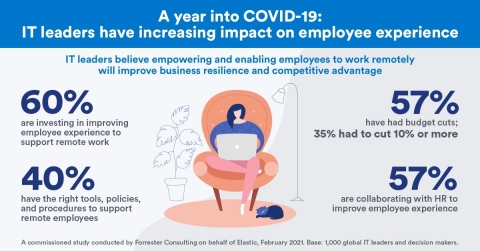New Study from Elastic Shows IT Leaders Believe Empowering, Inspiring, and Enabling Employees to Work Flexibly and Remotely Will Improve Resilience, Competitive Advantage, and Scale in Times of Disruption
MOUNTAIN VIEW, Calif.--(BUSINESS WIRE)-- Elastic (NYSE: ESTC) (“Elastic”), the company behind Elasticsearch and the Elastic Stack, today announced a new study that shows employee experience has become a new priority for IT leaders as they reinvent their infrastructures to support remote workforces. The commissioned study titled The Changing Role of the IT Leader was conducted by Forrester Consulting on behalf of Elastic in February 2021, one year into the global pandemic, and published in April. The study can be downloaded here.
This press release features multimedia. View the full release here: https://www.businesswire.com/news/home/20210412005230/en/

A year into COVID-19: IT leaders have increasing impact on employee experience (Graphic: Business Wire)
Based on a survey of 1,000 CIOs and IT leaders in 10 countries1, the study illustrates that an adaptive business model with employee experience at its core is the key to building business resilience, creating a sustainable competitive advantage, and scaling effectively in times of disruption.
Since the start of the COVID-19 pandemic, the shift to remote and hybrid working models has become a permanent fixture for many global organizations. Nearly 60% of IT leaders believe that enabling employees to work flexibly will improve the adaptiveness of their organizations and they are investing in technology to improve employee experience and productivity.
Globally, the partnership between IT and HR is growing stronger, with 57% of IT leaders collaborating more closely with their HR counterparts since the start of the pandemic.
While many IT leaders worldwide have pivoted to an employee-centric approach in their technology decisions, they still face barriers to establish an environment where IT fosters engagement and productivity.
IT leaders report that 92% of organizations worldwide are in survival or maintenance mode.
60% of IT organizations are investing in improving employee experience to support remote workforce productivity and performance, but don’t have access to the budget and tools to do so.
Find more information and view the full findings from the Changing Role of the IT Leader study here.
Supporting Quotes:
Methodology
For this study, “The Changing Role of the IT Leader” (April 2021) - commissioned by Elastic - Forrester Consulting conducted a global online survey of 1,000 CIOs and IT decision-makers and select in-depth interviews with CIOs and IT leaders in Australia, China, France, Germany, India, Japan, the Netherlands, North America, Singapore, and the United Kingdom.
About Elastic:
Elastic is a search company built on a free and open heritage. Anyone can use Elastic products and solutions to get started quickly and frictionlessly. Elastic offers three solutions for enterprise search, observability, and security, built on one technology stack that can be deployed anywhere. From finding documents to monitoring infrastructure to hunting for threats, Elastic makes data usable in real time and at scale. Thousands of organizations worldwide, including Cisco, eBay, Goldman Sachs, Microsoft, The Mayo Clinic, NASA, The New York Times, Wikipedia, and Verizon, use Elastic to power mission-critical systems. Founded in 2012, Elastic is a distributed company with Elasticians around the globe and is publicly traded on the NYSE under the symbol ESTC. Learn more at elastic.co.
The release and timing of any features or functionality described in this document remain at Elastic’s sole discretion. Any features or functionality not currently available may not be delivered on time or at all.
Elastic and associated marks are trademarks or registered trademarks of Elastic N.V. and its subsidiaries. All other company and product names may be trademarks of their respective owners.
View source version on businesswire.com: https://www.businesswire.com/news/home/20210412005230/en/
Elastic Public Relations Chloe GuillemotPR-Team@elastic.co
Source: Elastic N.V.